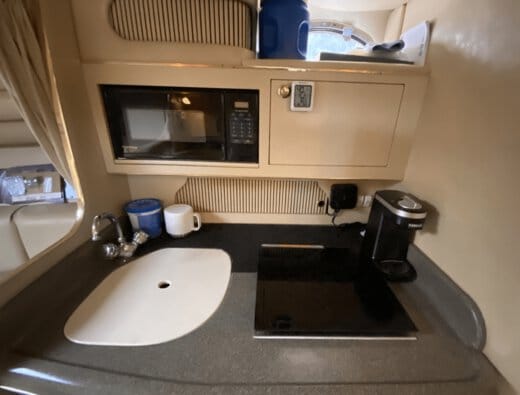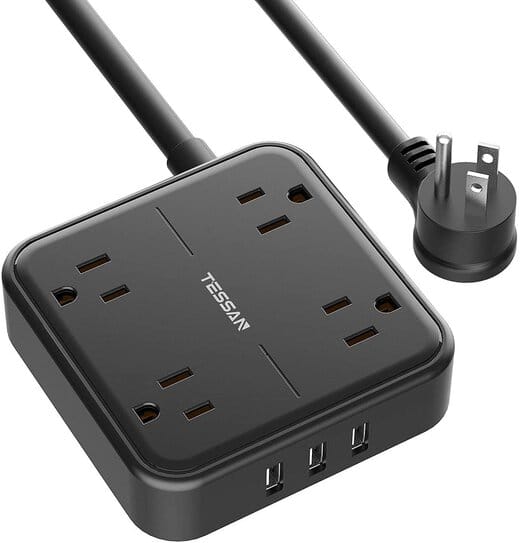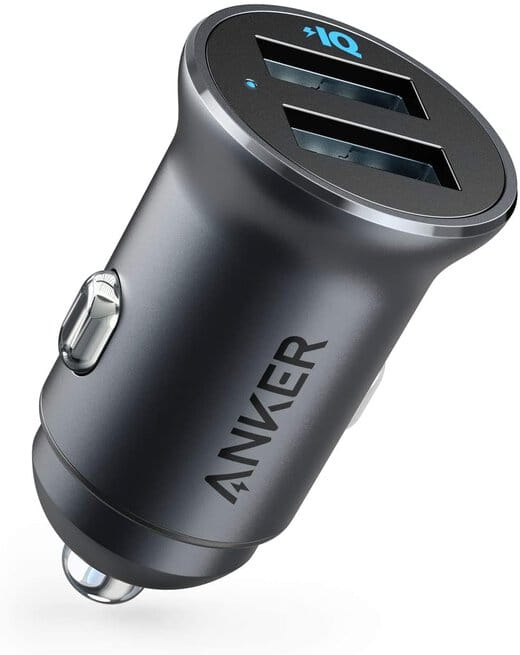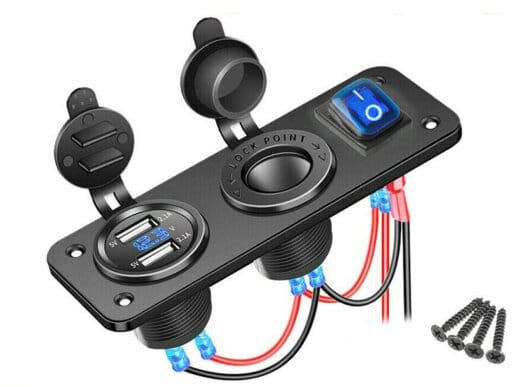AC and 12v Power
The 270SDA has 3 outlets inside the cabin, which is where I want to ensure we can manage to work from, overnight on, and generally have what’s needed and sane without power cords all over the place, or powering devices when we’re not there. Meanwhile, the SeaRay breaker panel includes the refrigerator along with the 110vAC outlets, while I want to leave the frig on.
Technically, there is some debate on the use of surge protectors onboard boats. I need to do some more research in this area, and may adjust accordingly, but as I had already found the first power solution. Do some research and make your own calls.
What I wanted to do is provide power where it’s most useful, in the way we use the boat, without fumbling with cords, but also being able to power down sections of devices to not be drawing at-rest current.
The first place to tackle is my ‘work from boat’ area, at least for the summer, amounting to the dinette area. The physically closest outlet unfortunately is right across from the dinette, in the cubby behind the galley stove and sink. While there was a ratty-looking extension cord from the PO in there, stringing lines across the main passageway in the cabin is not a sane idea.
The next closest one is right next to the mid-berth, between the bed and the closet there. Getting better, but still not great from an adding cables to trip over standpoint.
In an ideal world, there would be an outlet on the interior hull/fiberglass just below the table, or right on top of the port-side seating. I counted up our ‘normal and reasonable’ devices to plug into that area first - laptop, phone chargers, end the like for when in working mode, and decided we could really get by with only 2-4 actual outlets there, allowing for one of those outlets to go to a double USB/USB-C charger to handle my laptop and at least a phone charger. The same outlet count could also handle another USB-C charger if needed for my wife’s laptop.
Unfortunately, a straight line, or nearly-so, would require drilling through the vinyl and backing plywood and/or fiberglass, something which I’ve been trying to avoid, at least until we really get some time on the boat to ensure no ‘adjustments’ to ideas and layout are needed. Using a string to lay out the power strip cable routing, I decided the best outlet positioning also giving some chance to hide wiring in general would be below the table but mounted to the fiberglass. This also convenently would let me mount the power strip via command strips or industrial strength/width Velcro, avoiding drilling into the fiberglass altogether. I planned on mounting the power strip horizontally, and mostly hiding the cord in the upholstery seam, then running along the top and back of the dinette, then over and down to the outlet, which ideally would also have a flat and/or right-angle plug on it for general sanity. I could have been more thorough, measuring each angle and straight, but did some approximation, which landed me at between 11-14’ of cord needed on any power strip to tuck it away somewhat reasonably.
On the kitchen side of things, where we already have both a coffee maker and dehumidifer plugged in, I knew we’d wind up with ‘other things’ occasionally needing to plug in there, and wanted to tuck the cords and outlets out of the way as much as possible, so again, 3-4 outlets would suffice, intially thinking I’d mount this one on Velcro or Command Strips up to the underside of the shelf and below the power panel. This one ironically I wanted as short a power cord as possible, as in 1’ or less.
The search for sane power strips
As I wanted to leave things plugged in as much as possible in a ‘steady state,’ I wanted the power strips to have their own power switch, letting me effectively shut off everything plugged into outlets with a couple of switches, while leaving the refrigerator and dehumidifier running. This - made life more difficult. All kinds of options out there for travel, but nearly all are focused on ‘many many outlets’ once you get into longer cords.
Ultimately, I chose a Prime 6 Outlet metal surge protector with power switch, 6 outlet, with 15’ power cord for under the kitchenette table.
It has too many outlets, or at least more than I ‘needed,’ as well as the power cord being a bit too long, but it should be fine as the ‘central’/most outlets available in the cabin, centered around the dinette area. I may pull it apart yet once I finalize all of the wire routing to shorten the cord, or sort definitively if I should indeed ditch the surge protection portion, but it mounted well with Velcro and out of the way as I wanted, with a nice visible (when looking for it) power LED on a positive on/off/reset switch, and was long enough on the power cord, with a right angled flat plug, to get to where it needed to go. Everything plugged in there is turned off every time we leave the boat.
For the galley area,

I could have found something similar, hopefully with a much shorter cord, while retaining the visual and actual power switch. GE had some nice looking short cords with braiding and only 2-3 outlets, but - no power switch. :-/ Maybe it’s me but I’d prefer to not keep circuits energized that just don’t need to be, so I kept looking.
The overhang area is ~4.5” deep (the horizontal depth below the face of the power panel door face and the panel with the behind sink/stove cabinet, and there was no need for more than 3-4 outlets there at most. Again, this took a while - much easier to find without a power switch on it, but difficult to find the combination I was looking for including a short cord. Some had added USB ports, but with a switch that only turned off the USB ports, like an Anker I would have happily bought otherwise.
I wound up with a square 4 port by Tessan which also has USB(-A) ports on it which won’t hurt and maybe will see some use, possibly for charging our standalone JBL bluetooth speaker until I eventullay replace the Clarion head unit for something able to do Bluetooth or at least AUX input..mostly positive reviews overall across the brand, and it was one of the few that would fit in the space I was thinking.
The downside? It has a 5’ long power cord, where a 9-12” would have been just fine.
Going to do the install, I realized one other thing - the cord entry and power switch positioning to make it sit flat under the overhang weren’t really cooperating that well, at least with ideal cord layout, power switch accessibility AND not making the USB-A ports unusable by blocking them against the rear panel, so I did some adjustment of thinking and wound up with the pic shown.
I grabbed a velcro cable tie and tied the cord up so it stays out of the way inside the cabinet. The cabinet closes, except for the cord width, which I’ll wrap some silicon tubing around to avoid any fraying over time. The USB ports point straight up but are accessible now, it’s above the counter level in the event of sink or coffee splash, so calling it ‘good enough’ for the time being.
I do NOT like the fact that it has no LED showing power is on, but the switch is on the bottom right in this orientation and pressing on the right will turn it off, so will get used to it. Once again, I could have drilled a hole through the laminate into the cabinet, but as both ends of the power cord are molded/one-piece, I’d had to do some disaaembly and soldering to not drill a bigger-than-I’d-prefer sized hole, while I may elect to re-organize it at a later date, or perhaps with a unit with a lit LED and shorter cord. This one does NOT have surge protection, intentionally, while I sort the reality of ‘do or don’t’ for onboard surge protection. I can still get to the galley light switches to the right, although I’d prefer to not populate all 4 outlets if I can avoid it… I may yet wind up rotating it and mounting it horizontally, losing out on the USB-A ports, and adding a few no-drill cable organizers to route the power cord, but for now - it will work well enough.
For the V-berth area
For the last outlet in the cabin (V-berth side of galley/V-berth dividing wall), I’m holding off for the time being until we can sort which way we’ll be sleeping. At 6’ tall, it seems most likely we’ll sleep with our heads towards the galley vs the bow, getting a bit more leg room under the ‘back’ cushions. As we plan to leave the V-berth assembled a majority of the time, including the filler table section, pole and cushions, I expect it will be another shorter-cord strip with a power switch on it, primarily for phone and watch charging, as well as tablet when watching movies/Netflix/Prime/etc….but am still sorting how and where to mount a screen to do double duty for second display for work and watching flicks..so holding off for now.
Power Sockets
With the age of the boat, it’s unsurprising but still beneficial there are two ‘cigarette lighter’ 12v sockets - the first one at the helm, and the second next to the galley power outlet inside the cabinet.
I had originally bought a pair of dual USB-A ‘stubby’ 12v adapters, wanting them to use as little space outside the socket as possible, but the explosion of availability of various other options, as well as the power strip/USB-A combo I added in the galley, have me re-thinking that, which is OK as I’ll just throw any unused USB-A 12 adapters in my travel bag for trips and the occasional rental car without ‘enough’ USB ports.
I like Anker in general, so bought an Anker Flush fit 24W IQ adapter, along with one other generic to see which fit more flush…both were fine.
Searching eBay, Amazon and marine parts places will show a ton of ‘gadget options,’ pretty much taken from the automotive gadget industry but now being for ‘marine use.’ So much so, that most of the eBay ads saying ‘for marine use’ included pics showing installation in a car. Well - in this case, that’s not the end of the world really, as wiring is more or less wiring, and there’s really not much to it, other than I’ll likely heat-shrink some of the connections.
The original helm had a single 12v ‘cigarette lighter’ socket in it, and while adding the dual USB port adapter works, it didn’t let me close the rubber seal over the socket, and thinking about it further, it’s fairly likely I need at least 2 charging cables at hand when I’m at the helm, at least if I don’t wind up hard-wiring a GPS in the future, while some things do still indeed manage to want 12v cigarette lighter/socket connections…amazingly.
There are a ton of choices, including some panels with many more sockets or added guages, but ultimately, all I really wanted was this:
-
dual USB-A ports
-
Single 12v socket for generic catch-all adapters for random devices..
-
Working usable weather-seals for the sockets
As my OE voltmeter is flaky, although I have a replacement ready to install, I considered the panels with a third Voltage gauge in them, but wanted to minimize any expanded holes in the fiberglass helm. I also wanted to see if I could find one with, surprise - a power switch for the panel itself, although any current draw should be nearly non-existent. For $15 or so, and a slow trip from China, I finally came across the above, which while having dual sockets, manages to also embed a small voltmeter in the middle of the USB-A dual ports. I have since also found the identical unit on Amazon and am happy to see it has at least an average of 4 stars for reviews, so - we’ll see how it works out.
I’m not endorsing this one in particular to anyone, as I’ve yet to install it, but honestly, most of these things are very likely made by only a relatively small number of factories, or sometimes in the same factories, for different brands, including in some cases, brands we know that may charge more for in at least some cases, questionable value-added. While I’d love to buy US-made as much as possible, this just isn’t one of those places it’s even possible, so go with it, will add a small beat of sealant when I install it and see how it works out. It doesn’t have the up-rated USB ports of the Anker at 2.4W each, but I could always plug the Anker into the 12V socket if I have to.



